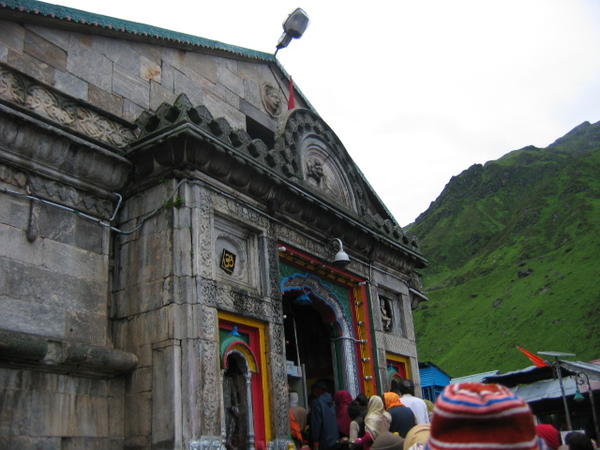The Indian land is embraced with a chaste essence of spirituality. With so many sacred places, the land stands as a hub for pilgrims. Various pilgrimages are arranged here round the year. The most revered pilgrimage in India is Chardham.

- Chardham YatraKumara Sastry / Foter.com / CC BY-NC-SA
Situated amidst the splendid arms of the Garhwal Himalayas, the expedition to Chardham covers four holy places – Yamunotri, Gangotri, Kedarnath and Badrinath. Each of the places holds spiritual and mythological values. The Yatra to Chardham begins from Akshaya Tritya and remains open for next six months. This year, Akshaya Tritya is on May 13, 2013 and thus, this is the opening date of the Chardham Yatra. Read below to have a virtual tour of the most sacred destinations of India.
Yamunotri
This is the first destination of the pilgrimage. As per the religious beliefs, Yamunotri is the origin of the holy river Yamuna. Saptrishi Kund, the glacial lake at the Kalindi Parbat is the real source of the sacred river. But the main temple of the place is located at an altitude of 3252 meters above the sea level. Devoted to Goddess Yamuna, the temple is built on the left bank of Yamuna. Before visiting the main temple, pilgrims worship Divya Shila, rock pillar.
Further, the thermal springs and glaciers add to the beauty of Yamunotri. Surya Kund is one of the most popular hot springs. The water of this spring is used to prepare prasad for the deity.
History
The temple of Goddess Yamuna was first built by Maharani Guleria of Jaipur in 19th century. However due to natural calamities, the temple got destroyed. The temple was then re-built, and again got devastated. The present temple is re-constructed after being damaged two times.
Mythological Beliefs
As per the legendary tales, sage Asit Muni resided in Yamunotri. During his life cycle he bathed daily in both the holy rivers (Ganga and Yamuna). However, in his old age he couldn’t go to Gangotri and then a stream of the holy river came down to his doorstep in the opposite direction as Yamunotri.
Further, Yamuna is regarded as the daughter of Surya, the Sun God and sister of Yama, the Lord of death. Thus, it is believed that by bathing in the river and by getting the blessings of Goddess Yamuna, one can get salvation.
Gangotri
After Yamunotri, the Yatra heads toward Gangotri. At a height of 3,100 meters, this holy place is regarded as the origin of river Ganga. Gomukh, the Gangotri glacier is the real source of Ganga and is a 19km trek from Gangotri. However, the main shrine is situated at the bank of Bhagirathi (Ganga), surrounded by rugged mountains at an altitude of 3,048 meters above the sea level. Further Alaknanda, the major tributary of Ganga comes from glacial waters near Badrinath and joins the Bhagirathi down at Devprayag for finally submerging in Ganga.
History
The Gangotri shrine was constructed by Gurkha General Amar Singh Thappa in the early 18h century. And, later in the 20th century Maharaja of Jaipur renovated the temple.
Mythological Beliefs
According to the Hindu mythological tales, King Bhagirath worshipped Lord Shiva for bringing holy Ganga on earth. After intense meditation, the king’s wish was granted and Ganga descended from heaven. However, the sacred river did not come directly on the earth; it remained in the hair locks of Lord Shiva and then came down on the earth. The spot where Lord Shiva mated Ganga in his locks can be witnessed as a ‘shivling’ submerged in the river.
Ganga came down to wash of the sins of King Bhagirath’s ancestors and thus the river here is known as Bhagirathi. Further, the stone slab known as Bhagirathi Shila, on which King Bhagirath meditated is still there near the temple and is worshipped by the pilgrims.
Kedarnath
Kedarnath, the third dham of the Chardham Yatra is devoted to Lord Shiva. The sacred place is known for having one of the twelve jyotirlingas. The famous Kedarnath temple is at an altitude of 3584 meters above the sea level. In addition to the main shrine, there are 200 other Lord Shiva temples and Shankaracharya’s Samadhi that pilgrims visit.
History
The main Kedarnath temple was built by Saint Adi Shankarachraya.
Mythological Belief
The mythological tale associated with the holy place is linked with Mahabharata (another Hindu legendary tale). It is said that after the war, the Pandav brother felt remorse for killing their own family and friends. For overcoming the guilt, they worshiped Lord Shiva. Then Lord Shiva came in a form of bull and submerged in the ground leaving his hump on the surface. The hump is regarded as the blessing of the lord.
Badrinath
This is the final destination of the Yatra. Badrinath is situated between the Narr and Naryana mountain ranges that are widely known as the land of Lord Vishnu. Various beautiful pictures of Lord Vishnu can be seen in the main Badrinath temple. Moreover, pilgrims visiting to the holy place can also take a tour to Panch Prayag that includes Devprayag, Rudraprayag, Nandprayag, Karnaprayag and Vishnuprayag.
History
The original temple was built by sage Shankarachraya when he found a Saligram in Alaknanda River. But owing to natural calamities, the temple was destroyed. Thereafter, it was re-built by King of Jaipur.
Mythological Belief
It is believed that Lord Vishnu meditated for 1,000 continuous years for the welfare of mankind. He meditated under the Badri tree and thus a mythological tale got attached.
So, after knowing about the famous Chardham, it’s time to book Chardham Yatra packages for getting spiritually enlightened.




